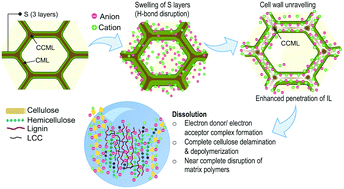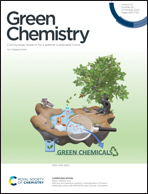Understanding the in situ state of lignocellulosic biomass during ionic liquids-based engineering of renewable materials and chemicals†
Abstract
Ionic liquids (ILs) can be used to sustainably convert lignocellulosic feedstocks into renewable bio-based materials and chemicals. To improve the prospects of commercialization, it is essential to investigate the fate of lignocellulosic biomass during IL-based processing and develop tools for designing and optimizing this “green” technology. In situ characterization during pretreatment and dissolution processes have shown that ILs reduced the inherent recalcitrance of lignocellulosic biomass via swelling of cellulose bundles and formation of fissures in the secondary cell wall layers. It subsequently enhanced the penetration of ILs into the plant cell wall leading to depolymerization and solubilization of matrix polysaccharides, mainly hemicellulose via deacetylation. Lignin also underwent dehydration or reduction reactions, depending on the IL type, with different mechanisms leading to the cleavage of inter-unit linkages. Following this process, the accessibility to cellulose microfibrils increased and induced delamination. Complementary X-ray diffraction analyses have elucidated that ILs also reduced cellulose crystallinity and altered cellulose polymorphs. High throughput in situ analyses, namely bright-field optical microscopy, nuclear magnetic resonance and Fourier transform infrared spectroscopies, have aided in monitoring the degree of swelling and chemical structural changes in lignocellulosic biomass during IL-based processing. Development of novel in situ analytical tools like IL-based gel permeation chromatography and rheometry will further shed light on molecular level changes in lignocellulose. Thus, an overall understanding of physico-chemical changes underwent by lignocellulosic biomass will help develop tools for monitoring and improving IL-based engineering of renewable materials and chemicals.



 Please wait while we load your content...
Please wait while we load your content...
